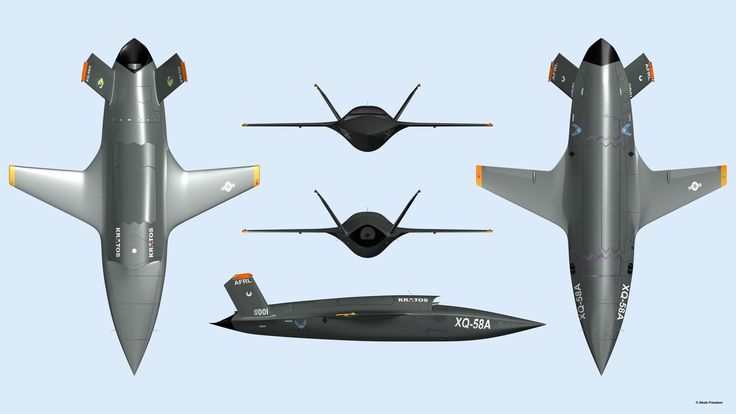Kratos’ Valkyrie XQ-58 drone is a stealthy unmanned combat aerial vehicle designed and built for the US Air Force
Kratos has supplied the first of two XQ‑58A Valkyrie unmanned drone to the US Air Force for use in testing autonomous systems.
The Valkyrie is a low-cost, high-performance unmanned aircraft. It is rocket-launched from a rail system and controlled from a ground station or airborne fighter. An onboard computer system is capable of determining the best flight path and throttle settings to comply with commands.
The Autonomous Aircraft Experimentation (AAx) team is using the 30ft long Valykrie at the Eglin Air Force Base Range in Florida, USA for developmental ground and flight testing.
This is the first time the Valykrie has been used by the military, so much of the aircraft’s infrastructure and logistics have to be created from the ground up and will be recorded.
Maj. John Nygard, 40th FLTS AAx team lead said, “When you combine the XQ-58A with the Eglin Range infrastructure, you get an uncrewed aircraft that enables real, open-air test of flight autonomy software capabilities while also proving out the resource requirements that could be used for future combat collaborative aircraft.”
The AAx team are testing autonomous aircraft in partnership with the Air Force Research Laboratory (AFRL).



“The data generated during previous tests, along with feedback provided from our user community, show that in order to rapidly develop and mature tactical autonomy on an appropriate timeline, investment in and utilization of appropriate military range resources is required,” said Matthew Niemiec, AFRL autonomous aircraft experimentation portfolio lead.
Military range resources are a major reason Valykrie testing is being conducted at Eglin. The Eglin Range communications supports infrastructure that will allow engineers at the ground station in its Central Control Facility to monitor the vehicle’s performance during flight.
Additionally, autonomous aircraft operations, airspace, and safety processes have been developed to enable safe and effective flight testing for uncrewed air vehicles.
The Valykrie’s first flight is scheduled for later this month.
Nygard described this new test as time-critical, with a lot to get done in a short amount of time. “The goal by fall 2023 is to leverage this platform for experimentation with crewed-uncrewed teaming display solutions,” said Nygard.
Additionally, the AAx team is building a data-storage and simulation environment to capture operator feedback and integrate their inputs into the autonomy software development process. The XQ-58A could host a variety of flight autonomy software solutions that were first tested in the simulator, including those from the Skyborg Autonomy Control System and others provided by third-party government and industry partners.
Niemiec said AFRL is working with multiple industry partners to integrate leading-edge autonomy capabilities onto the XQ-58A.
“The simulation investment enables us to focus flight test efforts of XQ-58A on developing the process to deliver autonomy software capable of accomplishing operator-defined missions to the warfighter,” he said.
Development and design
A XQ-58 Valkyrie deploys an Altius-600 unmanned aircraft system
The XQ-58 Valkyrie falls within the USAF Research Laboratory’s Low Cost Attritable Aircraft Technology (LCAAT) portfolio, whose objectives include designing and building unmanned combat aerial vehicles (UCAVs) faster by developing better design tools and maturing and leveraging commercial manufacturing processes to reduce build time and cost. The role of the LCAAT is to escort the F-22 or F-35 during combat missions, and to be able to deploy weapons or surveillance systems.
The XQ-58 is designed to act as a “loyal wingman” that is controlled by a parent aircraft to accomplish tasks such as scouting, defensive fire, or absorbing enemy fire if attacked. It features stealth technology with a trapezoidal fuselage with a chined edge, V-tail, and an S-shaped air intake. The XQ-58 is capable of being deployed as part of a swarm of drones, with or without direct pilot control. Though the XQ-58 is capable of conventional take-offs and landings, it can also be launched from “nondescript launch modules”, such as support ships, shipping containers, and semi-trailer trucks. Kratos could produce between 250-500 Valkyries per year.
Operational history
The XQ-58’s first flight took place on 5 March 2019, approximately two-and-a-half years from contract award. A total of five test flights were planned in two phases to evaluate system functionality, aerodynamic performance, and launch and recovery systems.
On 23 July 2020, the Air Force awarded contracts to Kratos, Boeing, Northrop Grumman, and General Atomics authorizing the companies to compete for the Skyborg program, an effort to field an unmanned wingman cheap enough to sustain losses in combat but capable of supporting manned fighters in hostile environments; Kratos may use the XQ-58 as its submission, although it was developed separately under the LCASD program and another airframe might be submitted. Kratos was further down-selected, along with Boeing and General Atomics, on 7 December 2020. Submissions were delivered by May 2021 for flight tests in July 2021.
On 26 March 2021, the XQ-58A completed its sixth test flight, opening the doors of its internal weapons bay for the first time and releasing a 27 lb (12 kg) Area-I Altius-600 small unmanned aircraft system (UAS)
